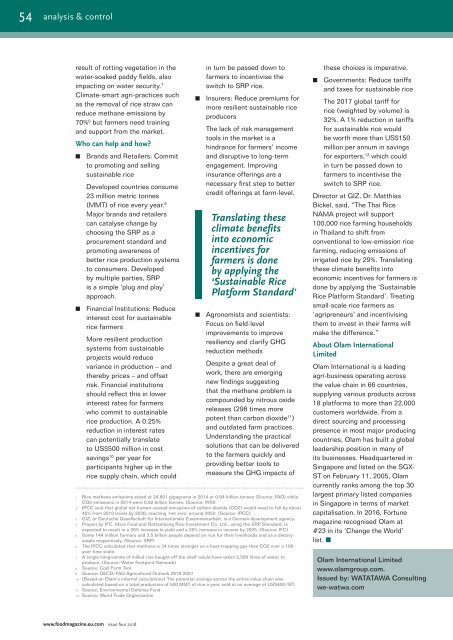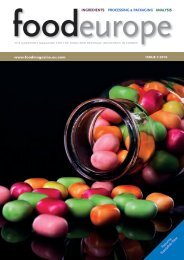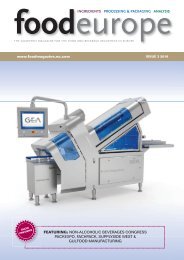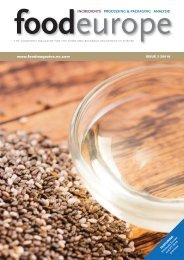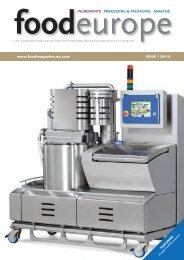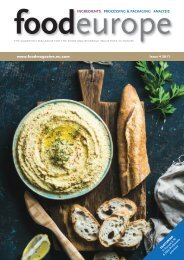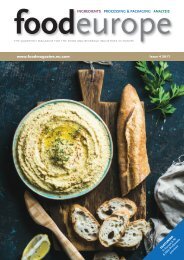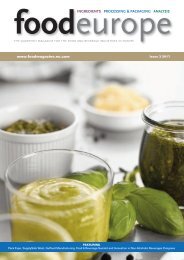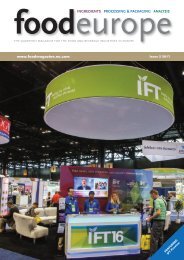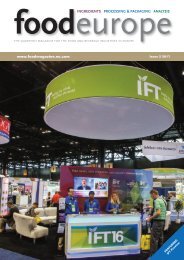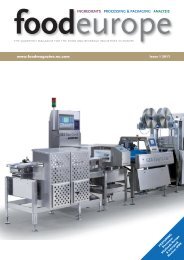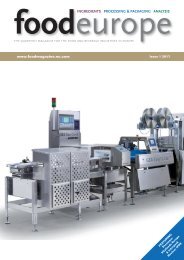Issue 4 2018
Create successful ePaper yourself
Turn your PDF publications into a flip-book with our unique Google optimized e-Paper software.
54 analysis & control<br />
result of rotting vegetation in the<br />
water-soaked paddy fields, also<br />
impacting on water security. 7<br />
Climate-smart agri-practices such<br />
as the removal of rice straw can<br />
reduce methane emissions by<br />
70% 8 but farmers need training<br />
and support from the market.<br />
Who can help and how?<br />
n Brands and Retailers: Commit<br />
to promoting and selling<br />
sustainable rice<br />
Developed countries consume<br />
23 million metric tonnes<br />
(MMT) of rice every year. 9<br />
Major brands and retailers<br />
can catalyse change by<br />
choosing the SRP as a<br />
procurement standard and<br />
promoting awareness of<br />
better rice production systems<br />
to consumers. Developed<br />
by multiple parties, SRP<br />
is a simple ‘plug and play’<br />
approach.<br />
n Financial Institutions: Reduce<br />
interest cost for sustainable<br />
rice farmers<br />
More resilient production<br />
systems from sustainable<br />
projects would reduce<br />
variance in production – and<br />
thereby prices – and offset<br />
risk. Financial institutions<br />
should reflect this in lower<br />
interest rates for farmers<br />
who commit to sustainable<br />
rice production. A 0.25%<br />
reduction in interest rates<br />
can potentially translate<br />
to US$500 million in cost<br />
savings 10 per year for<br />
participants higher up in the<br />
rice supply chain, which could<br />
in turn be passed down to<br />
farmers to incentivise the<br />
switch to SRP rice.<br />
n Insurers: Reduce premiums for<br />
more resilient sustainable rice<br />
producers<br />
The lack of risk management<br />
tools in the market is a<br />
hindrance for farmers’ income<br />
and disruptive to long-term<br />
engagement. Improving<br />
insurance offerings are a<br />
necessary first step to better<br />
credit offerings at farm-level.<br />
Translating these<br />
climate benefits<br />
into economic<br />
incentives for<br />
farmers is done<br />
by applying the<br />
‘Sustainable Rice<br />
Platform Standard’<br />
n Agronomists and scientists:<br />
Focus on field-level<br />
improvements to improve<br />
resiliency and clarify GHG<br />
reduction methods<br />
Despite a great deal of<br />
work, there are emerging<br />
new findings suggesting<br />
that the methane problem is<br />
compounded by nitrous oxide<br />
releases (298 times more<br />
potent than carbon dioxide 11 )<br />
and outdated farm practices.<br />
Understanding the practical<br />
solutions that can be delivered<br />
to the farmers quickly and<br />
providing better tools to<br />
measure the GHG impacts of<br />
1. Rice methane emissions stood at 24,801 gigagrams in 2014 or 0.84 billion tonnes (Source: FAO) while<br />
CO2 emissions in 2014 were 0.82 billion tonnes. (Source: WRI)<br />
2. IPCC said that global net human-caused emissions of carbon dioxide (CO2) would need to fall by about<br />
45% from 2010 levels by 2030, reaching ‘net zero’ around 2050. (Source: IPCC)<br />
3. GIZ, or Deutsche Gesellschaft für Internationale Zusammenarbeit, is a German development agency.<br />
4. Project by IFC, Mars Food and Battambang Rice Investment Co. Ltd., using the SRP Standard, is<br />
expected to result in a 20% increase in yield and a 25% increase in income by 2025. (Source: IFC)<br />
5. Some 144 million farmers and 3.5 billion people depend on rice for their livelihoods and as a dietary<br />
staple respectively. (Source: SRP)<br />
6. The IPCC calculated that methane is 34 times stronger as a heat-trapping gas than CO2 over a 100-<br />
year time scale.<br />
7. A single kilogramme of milled rice bought off the shelf would have taken 2,500 litres of water to<br />
produce. (Source: Water Footprint Network)<br />
8. Source: Cool Farm Tool<br />
9. Source: OECD/FAO Agricultural Outlook <strong>2018</strong>-2027<br />
10. (Based on Olam’s internal calculations) The potential savings across the entire value chain was<br />
calculated based on a total production of 500 MMT of rice a year, sold at an average of US$400/MT.<br />
11. Source: Environmental Defense Fund<br />
12. Source: World Trade Organization<br />
these choices is imperative.<br />
n Governments: Reduce tariffs<br />
and taxes for sustainable rice<br />
The 2017 global tariff for<br />
rice (weighted by volume) is<br />
32%. A 1% reduction in tariffs<br />
for sustainable rice would<br />
be worth more than US$150<br />
million per annum in savings<br />
for exporters, 12 which could<br />
in turn be passed down to<br />
farmers to incentivise the<br />
switch to SRP rice.<br />
Director at GIZ, Dr. Matthias<br />
Bickel, said, “The Thai Rice<br />
NAMA project will support<br />
100,000 rice farming households<br />
in Thailand to shift from<br />
conventional to low-emission rice<br />
farming, reducing emissions of<br />
irrigated rice by 29%. Translating<br />
these climate benefits into<br />
economic incentives for farmers is<br />
done by applying the ‘Sustainable<br />
Rice Platform Standard’. Treating<br />
small-scale rice farmers as<br />
‘agripreneurs’ and incentivising<br />
them to invest in their farms will<br />
make the difference.”<br />
About Olam International<br />
Limited<br />
Olam International is a leading<br />
agri-business operating across<br />
the value chain in 66 countries,<br />
supplying various products across<br />
18 platforms to more than 22,000<br />
customers worldwide. From a<br />
direct sourcing and processing<br />
presence in most major producing<br />
countries, Olam has built a global<br />
leadership position in many of<br />
its businesses. Headquartered in<br />
Singapore and listed on the SGX-<br />
ST on February 11, 2005, Olam<br />
currently ranks among the top 30<br />
largest primary listed companies<br />
in Singapore in terms of market<br />
capitalisation. In 2016, Fortune<br />
magazine recognised Olam at<br />
#23 in its ‘Change the World’<br />
list. n<br />
Olam International Limited<br />
www.olamgroup.com.<br />
<strong>Issue</strong>d by: WATATAWA Consulting<br />
we-watwa.com<br />
www.foodmagazine.eu.com issue four <strong>2018</strong>


